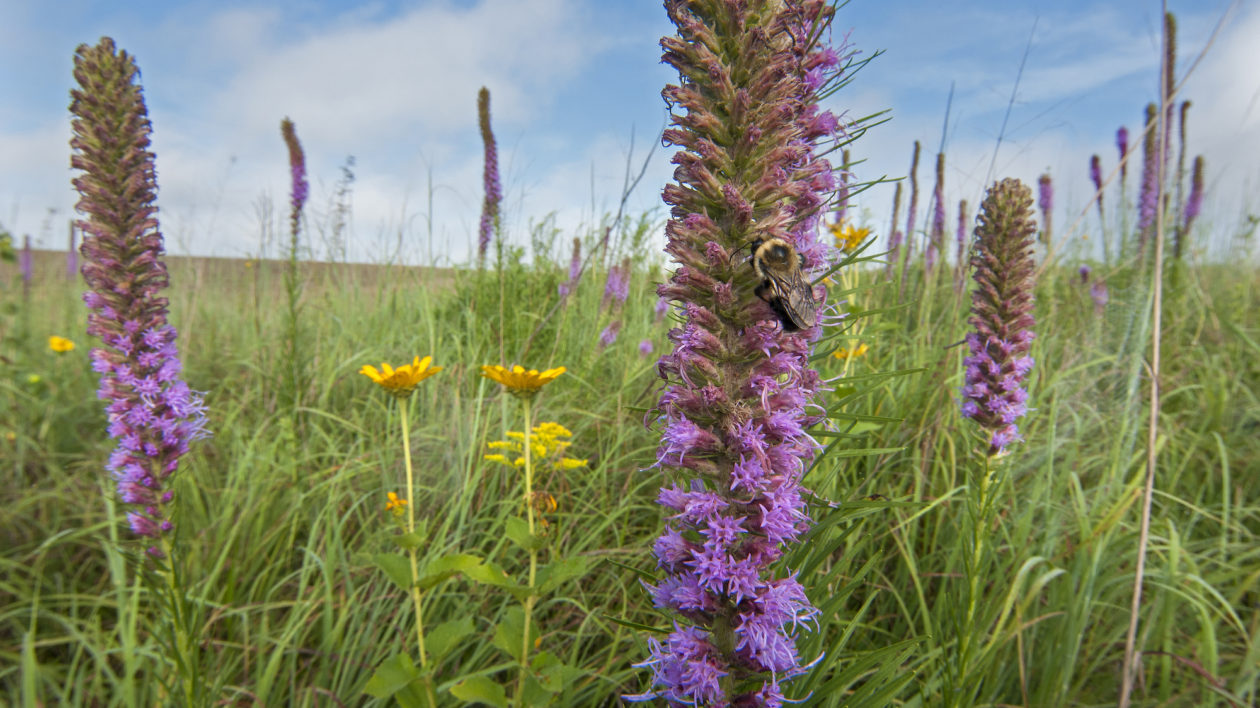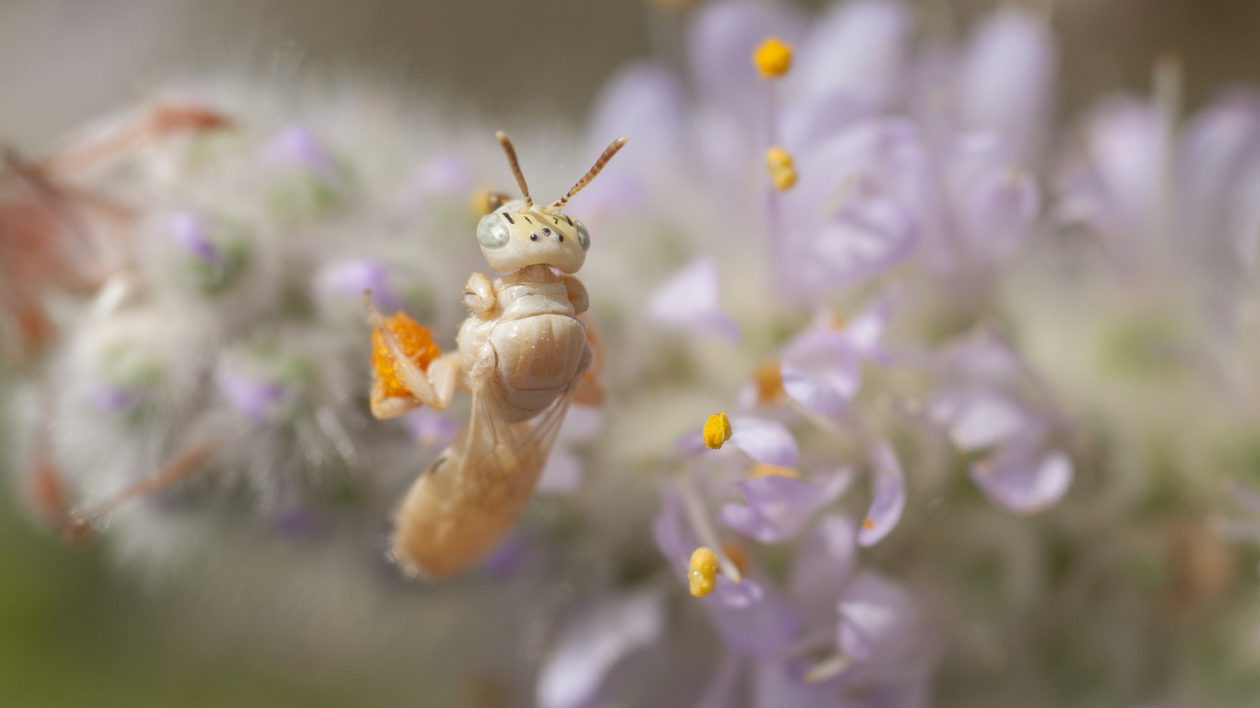The public is very aware that we are in the midst of a pollination crisis. In fact, concern about bees and other pollinators is nearly unanimous in public polling.
At a time when we are polarized on most issues, the need to do something about bees is something we can all agree on. Unfortunately, when people fret about bees and the threats they face, most are thinking about strictly about honey bees.
Honey bees are fascinating creatures. They’ve got an incredible social structure within their hives, they play important roles in the pollination of many food plants we like, and honey is delicious. However, honey bees are also an introduced livestock species in North America and only one of about 4,000 kinds of bees found in North America.
The thousands of native bee species living mostly below our collective radar are split into categories such as digger bees, carpenter bees, mason bees, sweat bees, bumble bees, and cuckoo bees.
The majority of those species don’t live in hives where workers cater to the needs of the queen and raise her babies for her. Instead, most native bees are reared in small nests built and tended by single mothers. Those female bees lay eggs, supply them with food, and protect them from enemies – all by themselves. A distinct minority of native bees live under some kind of cooperative system, and only a very few employ the kind of eusocial behavior we associate with honey bees.

The Dizzying Variety of Native Bees
Native bees also come in a dizzying array of colors, shapes, and feeding preferences. Bumble bees can be as large as your thumb, but many bee species are smaller than a grain of rice. Some are generalists that can feed opportunistically on whichever flowers are most abundant at the time.
Others are much more restricted in their diet, sometimes to a single species or group of species of wildflower. Plants, in turn, display a broad diversity of flower designs that can either make their nectar and pollen available to all comers or limited to only bees of a certain size, tongue length, or ability to vibrate flowers at a specific frequency.
Despite the astonishing variety among bees in North America, most conversations about bee conservation center on a single, largely agricultural species. Imagine if we did the same thing with birds — we’d be trying to raise more turkeys on farms out of concern for massive declines in overall bird populations.

To be clear, honey bees really are suffering declines. In fact, a recent report showed that around 38 percent of managed honey bee colonies in the U.S. were lost during the winter of 2018-19.
Honey bees are in no real danger of extinction, however, because humans are managing their populations. Native bees don’t have that kind of support system.
Honey bees also don’t cover the wide range of ecological roles played by our diverse native bee communities. The aforementioned variety of features and behaviors found within native bees means they can meet the needs of an incredible diversity of flowering plants. In contrast, honey bees provide pollination for a relatively small percentage of native flower species (estimates from around the world vary between 25 percent and 40 percent). In order to conserve the full species diversity and resilience of our ecosystems, we need our native bees.

The Fate of Native Bees
In addition to their inability to shoulder the entire load of pollination, there is also growing evidence that honey bees compete with and potentially contribute to the declines of native bees. That’s concerning, and it should make us thoughtful about how and where we place honey bee hives in and around natural areas. However, it’s also important to know that honey bees are not the primary reason our native bees are suffering.
In fact, honey bees and native bees share most of the same threats to their survival, with the loss of quality habitat topping that list. Similarly, many of the strategies to help save native bees will also help honey bees — and vice versa. We just need to be careful that saving honey bees aren’t the primary focus of conservation efforts or communications.
Increasing the size and quality of habitat for pollinators will boost populations of all bees, including both native bees and honey bees. Yes, certain pesticides and diseases are also causing major problems and we should continue to work on those issues as well.

However, adequate habitat quantity and quality greatly dampens the impacts of those other threats. We need to protect and restore plant diversity in natural areas and agricultural landscapes so that nectar and pollen resources are abundantly available throughout the year. In addition, we need to rebuild and reconnect floristically rich habitats wherever we can. Those are the only viable strategies to conserve bees of all kinds (and most of our native biodiversity).
Compared to those gargantuan tasks, changing the way we talk about bees seems pretty easy, but it is still really important. There are too many news stories that start with something like, “bees are suffering” and then proceed to talk only about honey bees.
Schools talk a lot about the social structure of honey bees, but don’t mention the majority of bees that don’t live that way. As a result, much of the public recognizes that we are experiencing a pollination catastrophe but thinks it’s an issue of bee keepers and their struggles to save their animals.
The real story of pollinators and their declines is much more compelling than the battle to save a livestock industry. The incredible variety among native bees, alone, can catch the public’s attention, especially when accompanied by photos showing the broad range of size, color, and shape among those bees.

People can also empathize easily with the extraordinary challenges facing single mom bees trying to feed and protect their progeny in a world of habitat fragmentation and degradation. Including butterflies, moths, flies, wasps and other insects in the discussion provides even more fascinating pollinator accounts and images.
The pollinator narrative is also easy to frame in ways that fit into the broader conservation context. Pollinators rely on habitat size, habitat connectivity, and plant diversity. Those are the key components of conservation success for most other species too, including our own.
Rebuilding and protecting the healthy and resilient landscapes bees need will provide for the needs of both nature and people. That’s a story we should be telling.

The public already cares about pollinators; we just need to be smarter about how we talk about them. If we’re successful, we’ll save much more than just bees. We can start by fixing our myopic focus on honey bees.
Turkeys are impressive and interesting creatures, but we’d never choose them as the primary focus of our bird conservation communications and strategies. Why, then, are we following that pattern for bees?
Let’s celebrate the incredible diversity of our native bee and pollinator communities and be more creative in the ways we engage the public on the topic of pollinator conservation. With 4,000 bee species in North America, along with countless other species of pollinators, it’s not like we’re short on material.




Fantastic article! Thanks
Great article!
I’m a Girl Scout leader and 2 of my 5th grade girls did their Bronze Award project about our native pollinators and what people can do to help them.
If you are looking to plant native, there are quite a few resources out there from the US Forest service, Fish & Wildlife Service, even the Audubon Society (though their lists focus on what is good for birds).
My girls found that the National Wildlife Federation’s to be particularly helpful.
https://www.nwf.org/Garden-for-Wildlife/About/Native-Plants/Native-Plant-Types
Could you mention the best Plants to help the wild Bees ?
Marianne, it varies wildly by site. Diversity is more important that particular species, especially diversity of flowers that ensure multiple species of plants are flowering at all times throughout the growing season. For more information, try this: https://xerces.org/pollinator-conservation/
Love NWF. But I have a question/comment. You really give no guidance on how to foster native bees other than plant nectar perennials. Which also serve honey bees so…. ok native bees are different and also important. Is that all the article was trying to convey?? If so fine but it seemed to be scolding us and implying we should be doing more for natives but not giving us any concrete steps…. please advise.
Mary, no scolding was intended. I just wanted to highlight the idea that we need to do more than just focus on a single species. Ensuring that a diversity of flowers are in your yard (including native plants as much as possible) is a great start. Beyond that, increasing habitat quantity and quality is the big key to success for all bees. That’s tough to fix as an individual person, but thankfully, there are great conservation organizations that are working on that, and you can support them! May I respectfully recommend The Nature Conservancy as one option? : )
What is the recommendation for us then ? What kind of native plants are best to plant?
Start here: https://xerces.org/pollinator-conservation/
I have long been interested in the natural world and our affect on it. This article has shown me something I have not been aware of. More info is needed especially what I can do with my small piece of land.
Thank you. I just did NOT know. I will spread this info as best as I can.
Chris,
Thank you so much for this great article and wonderful photos of a few native bees.
May I respectfully request permission to use your photos for educational purposes? I am a Master Gardener volunteer in San Diego. I volunteer to teach the public about earth friendly gardening and I am working on a presentation on pollinators. I need more photos of native bees.
Let me know if I have your permission to use these photos.
Thank you so much!
Hi Marsha, you’re certainly welcome to use the images for the use you mentioned. Feel free to visit prairieecologist.com and search for “bee” to find even more images.
well done , great article
Same problems here in South Africa.
We’ve been enjoying seeing the huge bumblebees in our garden. The Bee Balm is done now (they loved it!) but they are still buzzing around the larkspur, prairie clover and coneflowers. We see other bees, too. Thanks for the boost to native bees!
Enjoyed this article a lot, very informative. I’m trying to make my yard more pollynater friendly. I don’t use any pesticides. I’ve spot sprayed my alley and yard for sandburs and crab grass. I don’t like doing this but I don’t want the neighbors mad at me. I’ve had lots of bumblebees and wasp and a few other bees. Thanks for the article
I’d love to see regional lists of host plants and the bees they attract.
https://xerces.org/pollinator-conservation/
The Xerces Society is a great source of information on this topic.
I devoted my yard to help native bees
What types of healthy landscapes can be promoted. Is there a site to learn more listed by State and regions?
Check out https://xerces.org/pollinator-conservation/ for more information. They are a great resource.